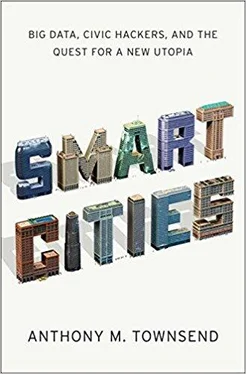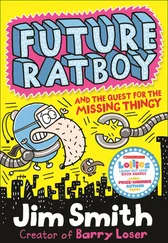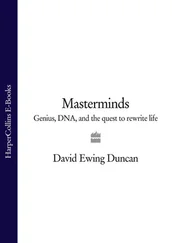Koreans’ approach to most everything, especially city building. No country has industrialized and urbanized as fast and as thoroughly as Korea did during the second half of the twentieth century. In 1953 the country lay in ruins, split in two by a civil war that claimed millions of lives. The citizens of Seoul began rebuilding from neartotal destruction. Between 1950 and 1975, the city’s population doubled approximately every nine years, growing from just over 1 million people in 1950 to almost 7 million people in 1975. But by the 1990s, according to a report by the Seoul Development Institute, the city’s urban-planning think tank, “one could say that Seoul was no longer an independent city but was rather the central city of a rapidly expanding metropolitan region of 20 million.” To call Songdo a new “city” is ill conceived— it is merely Seoul’s newest and farthest-flung satellite town.
As a test bed for digital technology, Seoul in the early twenty-first century is hard to beat, with over a decade of widespread experience with broadband Internet. After a bailout from the IMF during a financial crisis in 1997, South Korea embraced the Internet as an engine of economic recovery and social transformation. The national government modernized telecommunications laws, invested in a national broadband network, and launched a volley of new policies to push the use of broadband in education, health care, and delivery of government services. From just 700,000 mostly dial-up Internet subscribers in 1997, by 2002 Seoul was home to some 4.5 million broadband households. That year, as plans for Songdo were only just taking shape, one in every twelve broadband Internet users in the industrialized world was living in Seoul, and one in six was Korean. There were more broadband homes in the single city of Seoul than in the entire nations of Canada, Germany, or the United Kingdom. Over twenty thousand Internet cafes, or “PC bangs” (literally, “PC rooms”), had created a broadband culture unlike anything else on earth. The city was unique in the world, a glimpse into a high-speed connected future. Building Songdo was a natural next step. Much as Frank Lloyd Wright’s utopian 1932 plan for Broadacre City reimagined a thoroughly suburbanized America around the capabilities of the automobile, Songdo would reimagine the Korean metropolis around the potential of ubiquitous computing. It was, in fact, the first of a series of “u-cities” conceived by the national government to make Korea a world leader in smart-city technology and construction.
Korea is a prosperous nation, but Songdo was also an expression of anxiety about the rise of modern China, and the threats it would pose for the country’s high- tech industry. Korea was just on the verge of beating Japan in some industries (Samsung has decimated Sony’s lead in consumer electronics in recent years), but Chinese rivals were already plotting their own rise.
For Cisco, however, Songdo was a chance to get in early—not just the steadily evolving market for building automation, which was expected to grow at a tepid 3 percent a year—but the vast new high-growth market for technology-enabled infrastructure: roads, power grids, security, water, and sanitation.19 The technical challenge of interconnecting disparate sensors, control devices, and number-crunching computers was what Cisco was born of—the company had over three decades of experience weaving the individual pieces of the Internet together. In the beginning, building automation systems were proprietary, so you couldn’t mix and match. In the 1990s, several competing standards were developed that allowed devices from different manufacturers to work in concert, but they were far from perfect and for years there was no clear winner. Cisco’s vision was to accelerate this integration process and put everything in the city on a “convergence” network, talking to each other using Internet technologies and protocols. If it succeeded, Cisco would reap a nice fee for its hard work and cement itself deep within the basic operations of the city. “The popular technology of our time devotes itself to contriving means to displace autonomous organic forms with ingenious mechanical (controllable! profitable!) substitutes,” wrote urban scholar Lewis Mumford in 1961. Cisco seemed poised to write the next chapter in that story.
But for all its promise, it was clear during a visit in the fall of 2009 that pali pali urgency was in short supply at Songdo’s technology department. From the observation deck of the soon-to-be-completed Northeast Asia Trade Tower—at 1,000 feet above the coast, it is Korea’s tallest building—Songdo looks like any of dozens of new towns that have mushroomed on the outskirts of Seoul since the 1980s. Row upon row of identical apartment towers march off to the north and east, bearing oddly Western-sounding luxury brand names like “Hillmark” and “Worldstate.” Empty office blocks await the unlucky back-office departments that will be reluctantly relocated from Seoul to the sticks to keep the commercial side of this massive real estate project afloat. Songdo’s gambit for foreign investment hasn’t worked out as hoped— multinationals simply skipped over Korea to invest directly in mainland China. Pressure was mounting on Cisco and Gale International, the real estate development firm behind Songdo, to fulfill the projects lofty ambitions. In 2011, in a calculated effort to save face, Cisco published a thinly researched white paper frantically touting the social, economic, and environment benefits of smart cities. As Lindsay later explained to me, Songdo had become too big to fail.
From my perch, the “smart” face of Songdo was just as invisible as it was on the ground. A few years later, in 2012, Starbucks and start-up firm Square would announce a retail payment technology that tracks you by smartphone as you enter a shop and lets you pay simply by saying your name. Building a city around RFID cards seems, by comparison, sadly anachronistic. And unlike Digital Media City, an earlier effort to build a small-scale smart city on the edge of Seoul’s core, in Songdo the intelligence seemed deliberately tucked behind the scenes. Digital Media City’s plans were bold—massive building-sized screens, obelisks projecting social-media streams into public plazas, and free Wi-Fi everywhere. Compared to that design, which echoed Generator in its celebration of the messy human side of the city, Songdo seems intent on engineering serendipity out of the urban equation. In a world of YouTube, FaceBook, and LOLcats, something about Songdo just doesn’t feel authentic, fully reflective of our everyday digital existence.
For now, Songdo’s potential lies mostly in the somewhat distant future. The real magic of a fully networked and automated city won’t be seen until designers start writing code to program truly novel behaviors for entire buildings and neighborhoods. Thinking back to the original problem that faced Paxton as he sketched the Crystal Palace, how could a fully automated city respond to weather automatically as a system, and do it in ways that both reduced the use of energy and created a more delightful, human experience?
Imagine a late summer afternoon in Songdo a few years from now. Instead of thousands of individuals opening shades and adjusting thermostats, the entire city reacts to the setting sun in synchrony. Like desert plants, which open their stomata only at night to minimize water loss, Songdo’s smart buildings might order millions of remotely controlled motors to open windows and blinds to catch the evening sea breeze. Air conditioners and lighting are throttled back. Fresh air and the golden rays of the fading sun fill the city’s chambers.
This kind of city-scale performance will one day fulfill the potential of building automation. Life in smart cities will be defined by these dynamic, adaptive systems that respond in real time to changing conditions at the very small and very large scale simultaneously. They will fulfill the Frazers’ dream of a building that learns from and adapts to us—their moves will be scripted by insights drawn from torrents of sensed data. Indeed, in 2011, speaking at MIT, John Frazer noted that “things that were experimented in at a very small scale in the 1960s and 1970s now can be operated at city scale and even a global scale.”
Читать дальше












